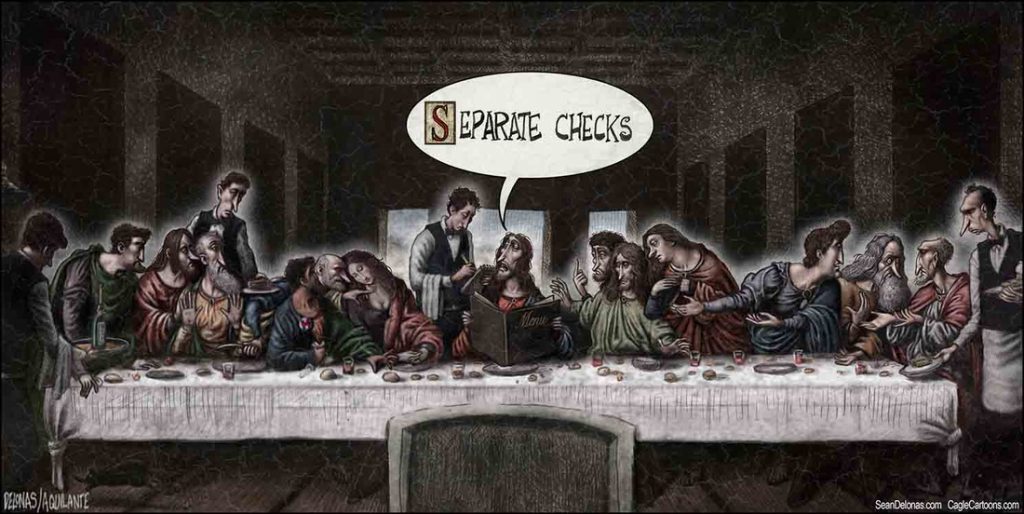The following is a chapter from Money, Sex, Power & Faith.
Order your copy in paperback or for Kindle!
“The Christian ideal has not been tried and found wanting. It has been found difficult; and left untried.” – G.K. Chesterton, What’s Wrong with the World

There are few places on Earth with as much concentrated wealth as Vatican City. As one of seven remaining absolute monarchies in the world and the foundation of the Catholic Church, no one can begin to estimate exactly how much wealth has accumulated there, but The Vatican Bank, a private bank with a limited clientele formally known as The Institute of Works of Religion, is said to hold about eight billion dollars in assets. With around 800 citizens, most of whom live abroad, and an estimated GDP of over 300 million dollars a year, Vatican City could be considered the wealthiest state in the world, per capita. That’s a lot of wealth, especially for a group of people who have pledged themselves to a life of poverty.
Yet each week, some 85 million Americans give at least ten dollars to their parish, boosting the economy by over 44 billion dollars a year. And that doesn’t even account for the rest of the 1.2 billion Catholics in the world, nor the members of the 33,000 international Protestant denominations.
Suffice it to say, there is a lot of money in religion, especially Christianity. Were this money used well and for more of the purposes highlighted in the red letter versions of the New Testament, chances are good that we’d be seeing a lot less hunger and homelessness in the world. But since Queen Elizabeth urged the government to start taking care of the indigent through welfare, that has freed up churches to focus on other aspects of the religion, like evangelism, politics, production value, and wealth development.
As Richard Halverson, former chaplain of the United States Senate, said, “In the beginning the church was a fellowship of men and women centered on the living Christ. Then the church moved to Greece, where it became a philosophy. Then it moved to Rome, where it became an institution. Next, it moved to Europe, where it became a culture. And, finally, it moved to America, where it became an enterprise.”
For instance, televangelists do little to nothing to feed the hungry, shelter the homeless, or visit the sick and imprisoned, as Jesus told his followers to do. Instead, they sell advertising and merchandise while begging people on fixed incomes for money so they can fund lavish lifestyles for themselves. And although they may not be following Jesus’ example nor commandments, because they say they are producing their theatrics in his name, they have built a two and a half billion dollar industry without even having to participate as citizens by paying taxes.
Since it comprises just under a third of the world’s population and forms the majority in 158 different countries and territories (about two-thirds of the countries in the world), if Christianity is not operating well, it can have a drastic effect on the rest of the population. Christianity has certainly changed since it started, originating in the loving messages of a humble carpenter urging people to simply love the source of all life as well as those who share it with you, only to transmogrify into the most powerful organization on the planet. Yet although it has arguably amassed more wealth than any other concerted effort in human history in the name of caring for the homeless, hungry, sick, and imprisoned, it seems to have veered from its original message and lost touch with its origin.
While Christianity may have its roots in the Middle East/North Africa, after it spread around the rest of the world, this region now has the smallest concentration of Christians on the planet. A century ago, about two-thirds of the world’s Christians lived in Europe, as they had been for a millennium. Now, only about a quarter remain in Europe, more than a third are in the Americas, an eighth in Asia, and a quarter in sub-Saharan Africa, where the percentage of Christians rose from 9% in 1910 to 63% in 2010. Christian missionaries have done such an incredible job of spreading the message to all parts of the globe that it is now so widespread that no single continent or region can indisputably claim to be the center of global Christianity. Yet although they are more spread out, as the world’s overall estimated population rose from 1.8 billion to 6.9 billion, the percentage of Christians around the globe has dipped a little from 35% to 32% of the population.
About half of the Christians in the world are Catholics, and about twelve percent claim to be Orthodox Christian, meaning, among other things, they do not strictly adhere to the Catholic Bible. A little less than forty percent of Christians are some sort of Protestant denomination, which means that while they no longer have such reverence for the Catholic priesthood, they still accept their scriptures as the only true Word of God. The remaining one percent of Christians are comprised of Mormons, Jehovah’s Witnesses, and other sects.
Ultimately, for the last thousand years or so, Western civilization has been guided heavily by the Judeo-Christian heritage. “It is in Christianity that our arts have developed,” wrote T.S. Eliot in Christianity and Culture: The Idea of a Christian Society and Notes Towards the Definition of Culture. “It is in Christianity that the laws of Europe – until recently – have been rooted. It is against a background of Christianity that all of our thought has significance. An individual European may not believe that the Christian faith is true, and yet what he says, and makes, and does will all spring out of his heritage of Christian culture and depend upon that culture for its meaning… I do not believe that culture of Europe could survive the complete disappearance of the Christian faith. And I am convinced of that, not merely because I am a Christian myself, but as a student of social biology. If Christianity goes, the whole culture goes.”
Since the Bible was first bound as a compartment for what we know as God in about 900 AD, ushering in the dawn of the Dark Ages and providing the impetus for the Crusades of Christianity, this collection of books has directed the course of our culture’s development by offering us a variety of stories, metaphors, laws, and practices that has arguably done as much to hinder our progress as a society as it has helped. And the same can unfortunately be said about the organizations that demand allegiance without fully embracing its core message.
Because the Roman Catholic Church and many of its Protestant subsidiaries have been established as corporations subservient to the debt-based monetary system, the movement of Christianity is not always very effective at meeting the mandates of its honoree. Many churches have been predisposed to channel great amounts of wealth to themselves, while others have tended to the cultivation of poverty. Many are merely organized more as defenders of ideas than as true representatives of Christ.
Sadly, it also seems the clergy of the Catholic church are no better at upholding their pledge to poverty as their pledge to chastity. Just as their wealth is derived from what was given to help the most vulnerable, their sexual hungers are also often satiated by those who are the most vulnerable. It is impossible to say how many children have been sexually abused by clergy in the Catholic Church, but it is probably safe to say that more children have been sexually abused by clergy in the Catholic Church than by any other organization in the world.
However, because the organization has done such an effective job of protecting the predators in their midst, it seems very unlikely that their victims will see any justice through the legal system. And because the belief system their abusers told them about grants religious rapists complete immunity from all transgressions in the afterlife, few people who have been sexually abused by ministers of the Christian faith will ever feel that justice has been served. Overall, it is estimated that only ten percent of sexual abusers will ever be prosecuted, yet it seems an even greater abuse when perpetrated within an organization offering comfort and sanctuary.
It is estimated that only about 32% of sexual abuses will be reported to police, and that number is most probably significantly reduced when those abuses are perpetuated within a religious organization. Most victims of religious sexual abuse fear coming forward because they do not want to disrupt the ministry. Although their own lives may be shattered, they cannot bring themselves to shake the faith of another and are still not compelled to leave the Church themselves. Those who have been mistreated by Christianity have often been its greatest defenders.
In the United States, which claims the top spot for most Christians living in the country (230 million of them), 72% of Christian women say religion is “very important” to them, compared to only 62% of Christian men. And while 74% of American women claim to pray every day, only 60% of men do. Across the board and around the world, women are more religious than men and certainly outnumber them in the pews, in spite of the fact that the religion regards them as the inferior gender.
Today, two-thirds of religious Americans still belong to a community that refuses to consider women for positions of leadership. The United Methodist Church didn’t ordain their first female minister until 1956, and The Evangelical Lutheran Church in America, Reform Judaism, and the Episcopal Church waited almost two decades before they did the same. Today, Catholics, Baptists, Mormons, Jehovah’s Witnesses, Orthodox Jews, Muslims, and most evangelical denominations still do not have enough respect for women to ordain them as ministers.
Even among homosexuals, who have been historically considered as an “abomination” in Christianity, based on a verse in the Jewish book of Leviticus and the writings of Paul, there is still great reverence for the Christian church. Based on a survey by evangelical pollster George Barna, 70% of gay Americans describe themselves as Christian, with 60% of them saying that their faith is “very important” in their lives.
Regardless of how Christianity, or the Judeo/ Christian/Islamic tradition at large, may reveal its fallibilities, whether they be financial indiscretions, sexual abuses, psychological abuses, or shirking responsibility, it is still dear to our hearts. The reasons why it is held in such esteem are likely as numerous as the people who hold them. Yet whether it be due to a true desire to follow in the example of Jesus, genuine fear of the eternal torment the religion describes, or simple tradition, there remains a fervor in the hearts of Americans and people around the world to embrace the message of selflessness and connection to our Creator at the heart of the words attributed to Christ.
And indeed, that faith is still put into action to help the hungry, homeless, sick, and in prison, among other things. A 2014 report by The Giving Institute found that 62% of religious households give to charity while only 46% of non-religious households do. Of course, this also means that religious organizations receive the largest share of that money.
The most recent estimates show that religious congregations received 41% of all charitable donations in 2016, and organizations with a religious identity received 32%, leaving only 27% of charitable giving for secular causes. So while religious organizations received a total of 122.94 billion dollars from American households, education, as the next largest subsector, only received 59.77 billion. In addition to those donations, religious organizations also receive a great percentage of their funding from taxpayers, as evidenced by The Economist‘s 2012 report that 62% of Catholic charities’ support came from local, state, and federal government agencies.
However, those religious organizations are providing a good part of social services, with Politifact estimating anywhere from 17-34% of all nonprofit social-service charity coming from Catholic charities alone. With cuts to spending for the federal government under the current administration, it is likely that religious organizations are going to have to increase their role in providing for the needy in America. Although a survey conducted by Duke Divinity School found that 83% of congregations have some sort of program to help needy people in their community, including food and clothing drives as well as temporary shelter, federal cuts to education, food stamps, Medicaid, homeless programs, and other services may put greater responsibility on religious organizations at a time when they are already finding it difficult to meet their demands.
Possibly due to the number of scandals that have permeated religious organizations, fewer people now say they believe in God than they did a few decades ago. When Gallup started asking people if they believed in God in 1965, 97% were affirmative, a number that has dropped to 86% in recent years, with only 56% saying they believe in the anthropomorphic God of the Bible, and 33% believing in a more abstract spiritual force. Additionally, Pew Research Center’s 2014 Religious Landscape Study shows that the number of self-identified Christians in the US declined by 7.8% between 2007 and 2014.
With attendance down, religious organizations are in danger of receiving less money to operate, which is already a challenge in itself. Numerous studies into church spending have found that roughly 50% of a church’s budget is spent on pastoral and staff salaries, with another 22% going toward property expenses, leaving little more than a quarter of the budget for church programs, missions, and actually serving the needy. Now, possibly more than ever, we could use some actual faith.
Order your copy of Money, Sex, Power & Faith today!


